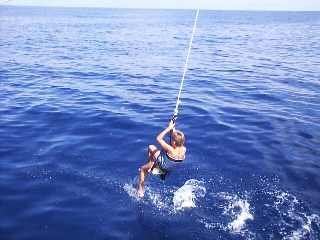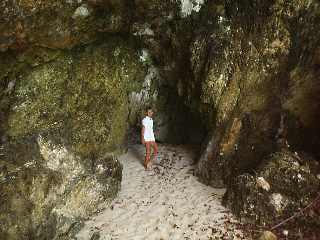

Liz's Journal - Curacao to Haiti
Page 15
We rigged up the boatswains chair on the end of the spinnaker pole, and moved the pole over the water. We had a lot of fun sitting in the chair over the water, our feet occasionally dipping into the water in rhythm as the boat rolled on the ever-running swells. A few miles off the coast of Haiti we started seeing things floating in the water, and not being in a hurry we changed direction every now and then when we saw something floating by.
The first thing we found was a large fishing float that had no doubt broken loose from the mooring and was on its way to Panama. Growing on and around the float are barnacles, crustaceans, a large variety of small reef fish and feeding off them were a family of Dorado, also known as Mahi-Mahi.
We caught a few of the Dorado, only keeping one to eat. A few logs drifted by, one of which had become the temporary residents for two baby Cormorants. Grouper and other reef fish were also founf swimming around the logs, they were quite a distance from their natural habitat.

The island of Hispaniola is divided into two parts, the Dominican Republic and Haiti.
The national language in Haiti is French. We made landfall at "Ille a Vache", a small island just a few miles off the coast of Haiti.
Little sailboats made out of various natural materials came out to meet us. The Hull, a hollowed out mango tree trunk, the mast and boom constructed from bamboo poles, the sails are from white and black plastic bags stitched together. There are numerous little bays along the rocky coast, we chose a little sheltered bay quite a few miles away from the hustle and bustle of the main village.
The water is clear and cushion starfish litter the sea floor. We hadn't even dropped anchor when two men came out to meet us in their little dug out canoes. If you spray paint the topsides of your boat I wouldn't recommend going to Haiti, as the canoes, although not very strong can scratch your hull. No money is exchanged so trading is essential.
The island is mainly forest, land is cleared away for crops and houses. There are many caves that surround the island, there was a little slit in the rock, we would never have found it if it weren't for Jack. Squeezing through this tiny vertical hole, you come out at the other end and find yourself standing in a huge cave. Following the cave for about 20 yards you come to an opening, the ivy and creepers almost blocking your view of the bay.